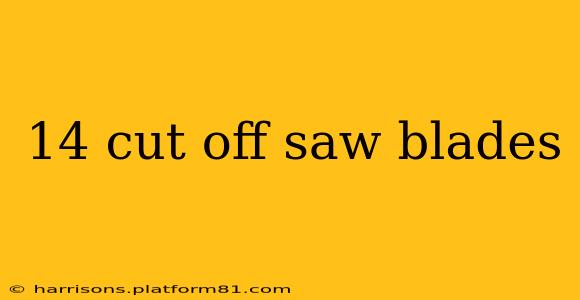Choosing the right cut-off saw blade is crucial for achieving clean cuts, maximizing blade life, and ensuring operator safety. This guide focuses specifically on 14" cut-off saw blades, exploring their applications, types, and key considerations for selection. Whether you're a seasoned professional or a DIY enthusiast, understanding these factors will help you make an informed decision.
What are 14" Cut-Off Saw Blades Used For?
14" cut-off saw blades are versatile tools used in a wide range of applications, both in industrial settings and for smaller-scale projects. Their large diameter allows for efficient cutting of thicker materials and larger workpieces compared to smaller blades. Common applications include:
- Metal Cutting: Cutting various metals, including steel, aluminum, stainless steel, and even some exotic alloys. The specific blade type will depend on the metal's hardness and composition.
- Abrasive Cutting: Cutting materials like concrete, brick, and stone. Abrasive blades are designed for tougher materials that would quickly dull standard metal-cutting blades.
- Wood Cutting (Less Common): While not their primary application, some 14" blades can be used for cutting wood, although dedicated wood-cutting blades are usually preferred for optimal results.
What are the Different Types of 14" Cut-Off Saw Blades?
Several factors determine the type of 14" cut-off saw blade you need. The most important are the material being cut and the desired cut quality. Here are the main types:
-
High-Speed Steel (HSS): HSS blades are durable and relatively inexpensive, suitable for general-purpose cutting of mild steel and other softer metals. They are not ideal for high-volume production or cutting tougher materials.
-
Bimetal Blades: These blades combine a high-speed steel tooth segment with a high-flexibility body. This design provides a balance of durability and flexibility, enabling them to handle tougher materials and produce straighter cuts.
-
Carbide-Tipped Blades: Carbide-tipped blades are significantly more durable than HSS or bimetal blades, allowing for much faster cutting speeds and longer blade life, especially when cutting harder materials. They're ideal for high-volume cutting of tough metals and alloys.
-
Abrasive Blades: Specifically designed for cutting non-metallic materials like concrete, brick, and stone, these blades utilize an abrasive segment to effectively cut through these materials. Different abrasive types exist, each tailored to specific materials.
What are the Key Features to Consider When Choosing a 14" Cut-Off Saw Blade?
Several key features impact a 14" cut-off saw blade's performance and longevity:
-
Tooth Geometry: The shape and spacing of the teeth affect the cutting speed, cut quality, and material removal rate. Different tooth designs are optimized for different materials.
-
Blade Thickness: Thicker blades are more durable but may require more power to operate. Thinner blades are more flexible and produce cleaner cuts, but they may be more prone to breaking.
-
Arbor Size: Ensure the arbor size (the hole in the center of the blade) matches your cut-off saw. Common arbor sizes include 1" and 1 1/4".
-
Kerf: The kerf is the width of the cut made by the blade. A narrower kerf reduces material waste, but it also puts more stress on the blade.
How Do I Choose the Right 14" Cut-Off Saw Blade for My Needs?
Selecting the proper 14" cut-off saw blade requires careful consideration of the material being cut and the desired cut quality. For example:
- Cutting Steel: Consider carbide-tipped blades for hard steel or bimetal blades for general-purpose cutting of mild steel.
- Cutting Aluminum: HSS or bimetal blades will usually suffice.
- Cutting Concrete: An abrasive blade is essential.
Always consult the manufacturer's specifications to ensure the blade is appropriate for your application and saw.
What safety precautions should I take when using a 14" cut-off saw blade?
Safety is paramount when working with cut-off saws. Always wear appropriate personal protective equipment (PPE), including:
- Eye protection: Safety glasses or a face shield are essential to protect your eyes from flying debris.
- Hearing protection: Earplugs or earmuffs are recommended to protect your hearing from the loud noise generated by the saw.
- Gloves: Wear gloves to protect your hands from cuts and abrasions.
- Proper Clothing: Avoid loose clothing or jewelry that could get caught in the blade.
Always ensure the blade is properly secured before operation and follow the manufacturer's instructions carefully.
What is the lifespan of a 14" cut-off saw blade?
The lifespan of a 14" cut-off saw blade depends on several factors, including the material being cut, the cutting speed, and the blade's quality. Proper blade maintenance, including regular inspection and sharpening (where applicable), can significantly extend its life. However, blades will eventually wear out and require replacement.
This guide provides a comprehensive overview of 14" cut-off saw blades. Remember to always prioritize safety and select the appropriate blade for your specific application. Further research into specific blade manufacturers and their product lines can help you make an even more informed purchase.
